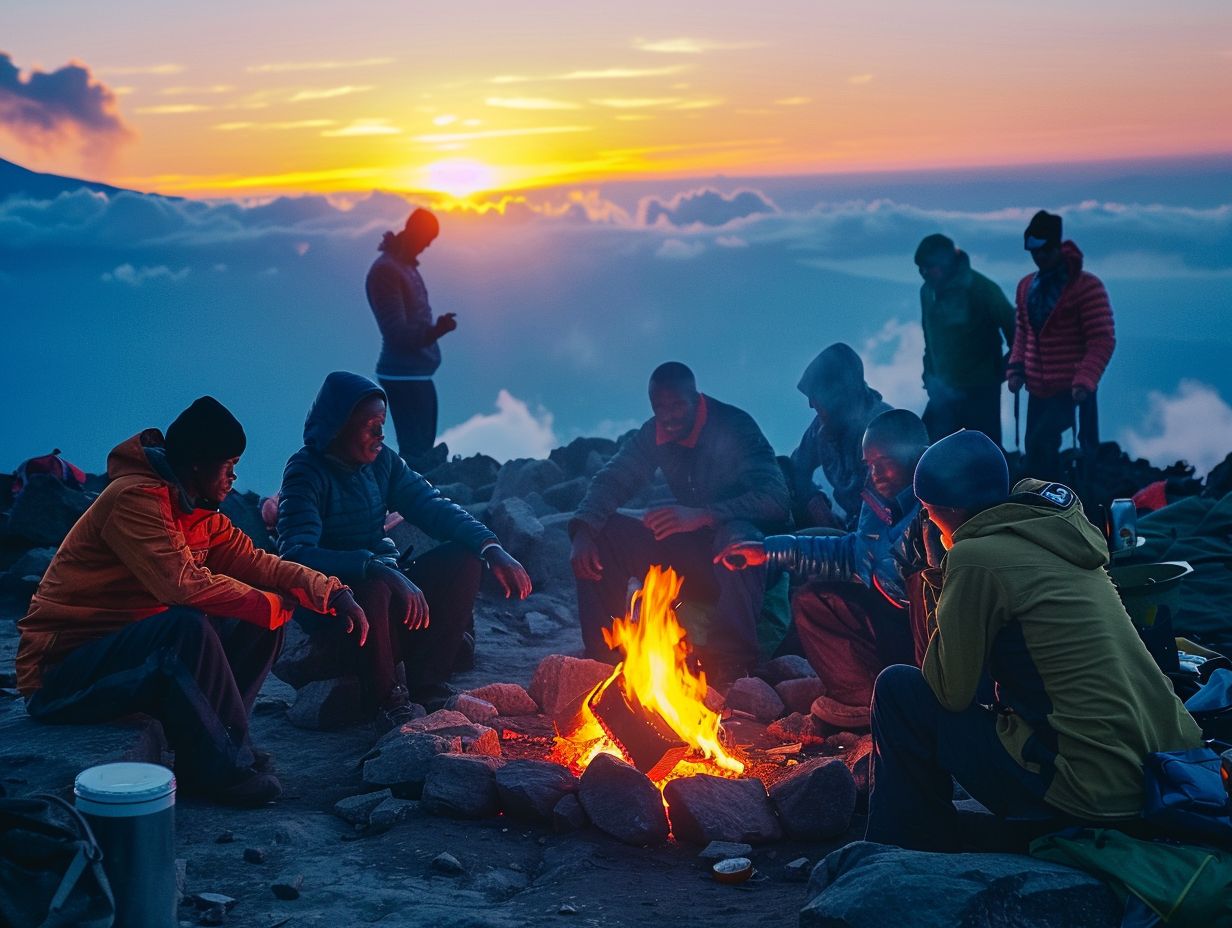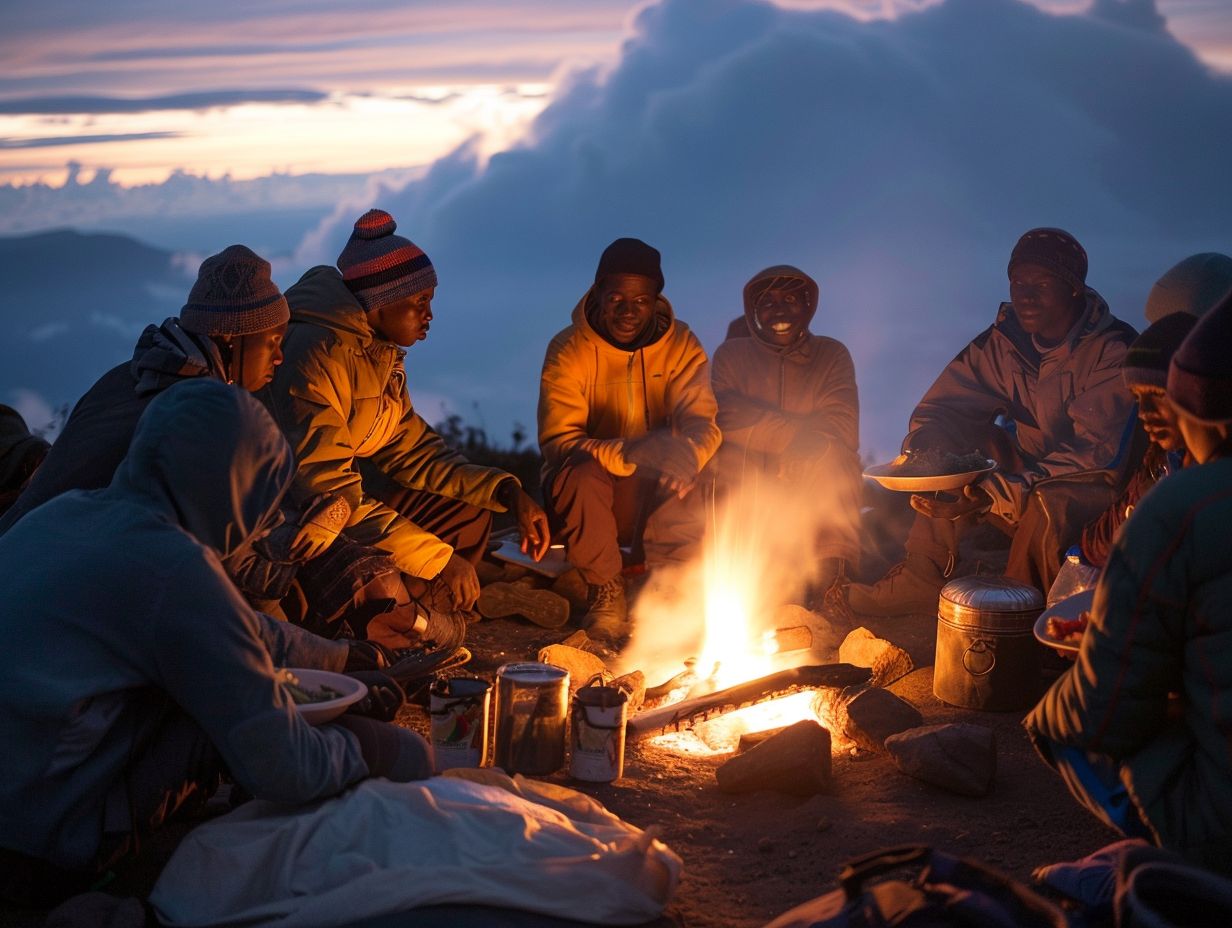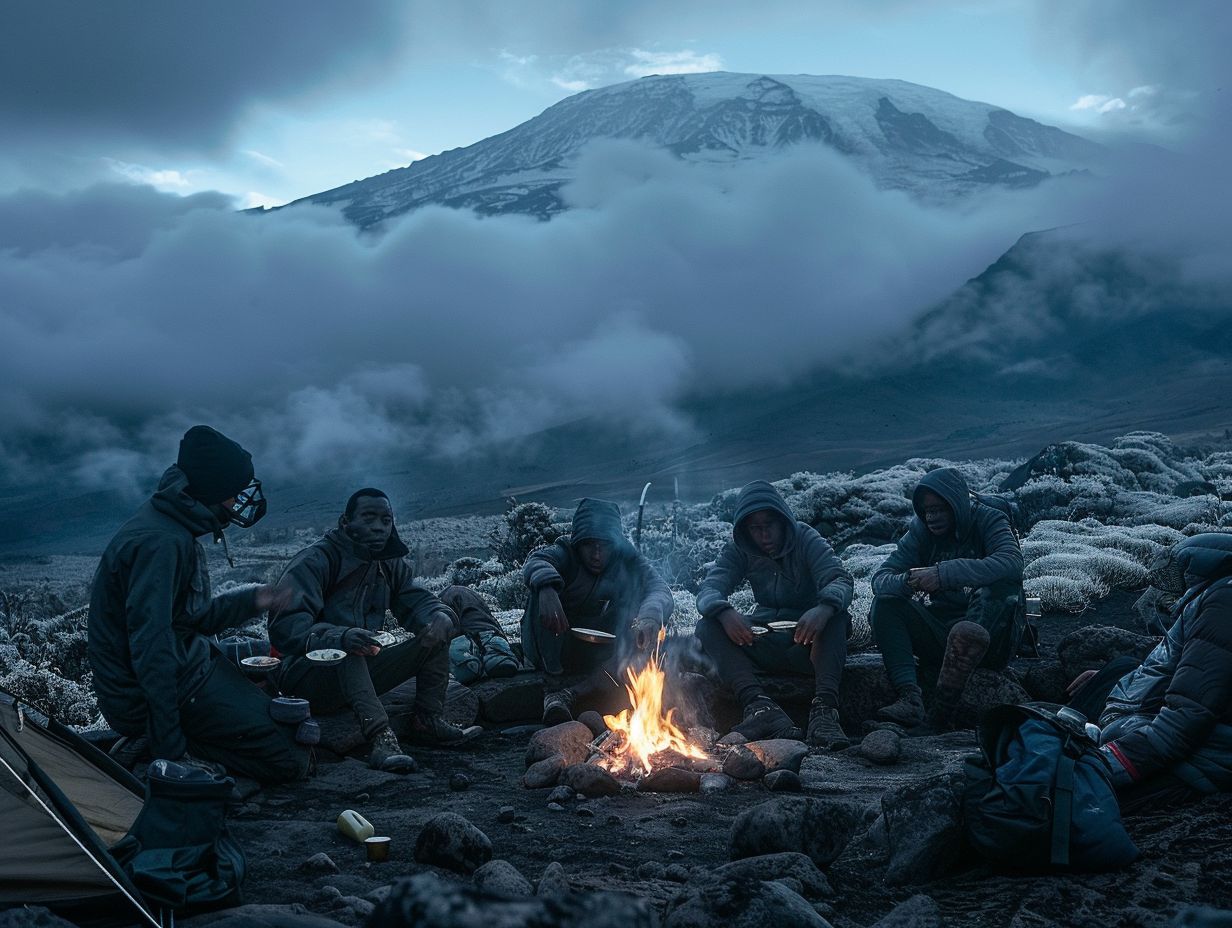
Food On Kilimanjaro
Are you planning a climb up Mount Kilimanjaro?
One of the key factors to consider is the food you will bring with you on this challenging journey.
From dealing with the high altitude to limited supplies and cooking difficulties, there are several challenges to overcome.
We will explore the recommended foods for climbing Kilimanjaro, foods to avoid, how much food to bring, meal ideas, and tips on preparing and packing food for your climb.
Let’s get started!
Key Takeaways:

- Eating a balanced diet with an emphasis on carbohydrates, proteins, and fruits and vegetables is crucial for success on Kilimanjaro due to the high altitude and limited availability of supplies.
- Avoiding high-fat, processed, and spicy foods can help prevent altitude sickness and digestive issues while climbing Kilimanjaro.
- Proper planning and preparation are necessary when packing food for a Kilimanjaro climb, including considering meal ideas for breakfast, lunch, and dinner to keep climbers nourished and energized.
What Are the Challenges of Food on Kilimanjaro?
Ensuring proper nutrition and hydration poses significant challenges when climbing Kilimanjaro due to the high altitude, limited availability of supplies, and difficulties in cooking amidst the demanding climb.
The impact of altitude is one of the primary concerns when it comes to maintaining adequate nutrition and hydration during a Kilimanjaro trek. The higher you ascend, the lower the oxygen levels, making digestion and nutrient absorption more challenging. As a result, trekkers often face loss of appetite and may struggle to consume enough calories and fluids to sustain their energy levels.
The scarcity of resources on the mountain adds another layer of difficulty. Water sources are limited, and purification methods are essential to prevent dehydration and waterborne illnesses. Carrying enough supplies of nutrient-dense foods becomes crucial, often requiring careful planning and packing of lightweight, high-energy snacks.
-
High Altitude:
The high altitude on Kilimanjaro presents a formidable challenge for climbers, affecting oxygen levels, metabolism, and leading to altitude sickness, which emphasizes the importance of proper acclimatization.
At high altitudes, the availability of oxygen decreases due to lower atmospheric pressure, making it harder for climbers to breathe efficiently.
This reduction in oxygen levels can have profound effects on the body’s metabolic processes, slowing down energy production and overall performance.
The rapid ascent to high altitudes without proper acclimatization increases the risk of altitude sickness, characterized by symptoms like headache, nausea, and fatigue.
Therefore, it is crucial for climbers to acclimatize gradually, allowing their bodies to adjust to the lower oxygen levels and reduce the chances of altitude-related health issues.
-
Limited Availability of Supplies:
The limited availability of food and water supplies on Kilimanjaro necessitates careful planning, including catering arrangements, menu selections, and ensuring chefs can accommodate various dietary requirements.
Ascending Kilimanjaro presents a unique set of challenges when it comes to sustaining climbers. With limited resources at higher altitudes, climbers and their support teams must be strategic in managing food and water consumption. The fluctuating weather conditions and demanding physical exertion amplify the criticality of adequate nutrition and hydration.
Chefs play a vital role in this equation by designing menus that strike a balance between providing energy-rich meals and meeting individual dietary restrictions. Their ability to prepare meals that are both nourishing and appetizing is crucial in maintaining climbers’ strength and morale throughout the expedition.
-
Difficulty in Cooking:
The challenging conditions on Kilimanjaro, including limited resources and high altitudes, make cooking a demanding task that requires strict adherence to safety and hygiene standards, underscoring the crucial role of proper catering.
At such heights, the boiling point of water is lower, affecting cooking times and recipe outcomes. This necessitates adjusting cooking methods to ensure food safety and taste consistency. Proper hygiene practices become even more critical to prevent foodborne illnesses in these extreme conditions.
Due to the limited resources, efficient meal planning and preparation are essential for sustaining energy levels during the climb. Therefore, a well-thought-out catering strategy that accounts for altitude-related challenges is key to a successful culinary experience on Kilimanjaro.
What Are the Recommended Foods for Climbing Kilimanjaro?
Choosing the right foods for climbing Kilimanjaro is crucial for sustaining energy levels and meeting the physical demands of the ascent. Recommended foods include those rich in carbohydrates, proteins, and essential nutrients like fruits and vegetables.
Carbohydrates are vital for providing the body with the necessary fuel to endure the challenging trek. They are a primary energy source that can help climbers combat fatigue and maintain stamina throughout the climb. Opt for complex carbohydrates such as whole grains, oats, and brown rice for sustained energy release.
Proteins play a key role in muscle repair and recovery, making them essential for climbers facing the physical strain of ascending Kilimanjaro. Lean meats, fish, nuts, and legumes are excellent protein sources that aid in muscle preservation and strength during the climb.
Incorporating a variety of fruits and vegetables into your diet is essential for obtaining a range of vitamins, minerals, and antioxidants that support overall health and immune function. These nutrient-dense options can help replenish electrolytes lost through sweat and provide hydration from their high water content.
-
Carbohydrates:

Carbohydrates play a vital role in fueling the body during a Kilimanjaro climb, providing essential energy to sustain the physical exertion and maintain optimal performance throughout the trek.
Carbohydrates are the primary source of energy for the muscles and brain, making them critical for climbers tackling the challenges of high-altitude treks. Incorporating complex carbohydrates in the diet, such as whole grains, fruits, and vegetables, ensures a slow and steady release of energy, which is crucial for the endurance needed on a demanding climb like Kilimanjaro.
Planning carbohydrate-rich meals is key to meeting the high caloric demands of such a strenuous activity, enabling climbers to replenish their glycogen stores efficiently.
-
Proteins:
Proteins are essential for muscle repair and recovery during a Kilimanjaro climb, supporting metabolic functions and ensuring the body has the necessary building blocks for endurance and strength.
Proteins play a crucial role in maintaining overall physical resilience, helping climbers withstand the strenuous demands of high-altitude trekking. These macronutrients are not just vital for muscle maintenance, but they also assist in energy metabolism, ensuring that climbers have sustained energy levels throughout their ascent.
Proteins are like the building blocks of the body, providing amino acids that aid in repairing muscle tissue that gets damaged during intense physical exertion. They are essential for recovery after challenging climbs and are key in replenishing the body’s energy reserves for subsequent days of climbing.
-
Fruits and Vegetables:
Incorporating a variety of fruits and vegetables into the diet for a Kilimanjaro climb is essential for providing essential nutrients, hydration, and maintaining a balanced meal plan that supports the body’s needs throughout the trek.
When undertaking a challenging ascent like Kilimanjaro, these natural nutrient powerhouses offer a plethora of vitamins, minerals, and antioxidants, crucial for fueling the body and aiding in recovery.
Fruits like bananas provide a quick energy boost while vegetables like spinach offer essential iron for oxygen transport. The high water content in fruits like watermelon and cucumbers aids in hydration, keeping climbers energized and focused.
Including these colorful staples ensures a well-rounded diet that not only tastes refreshing at altitude but also keeps exhaustion at bay.
What Are the Foods to Avoid on Kilimanjaro?
To maintain optimal performance and avoid digestive issues during a Kilimanjaro climb, it is important to steer clear of high-fat foods, processed items, and overly spicy dishes that may not align with dietary restrictions or the body’s needs in high-altitude conditions.
High-fat foods can be hard to digest at higher altitudes, potentially leading to discomfort and decreased performance on the mountain. Similarly, processed items often lack the vital nutrients required for sustained energy and focus during the ascent. Spicy dishes can irritate the stomach, causing unnecessary challenges during the climb and potentially impacting overall well-being.
Therefore, opting for nutrient-dense meals, rich in whole foods like fruits, vegetables, and lean proteins, is crucial for maintaining strength and vitality throughout the challenging journey.
-
High-Fat Foods:
High-fat foods can hinder digestion and slow down metabolism during a Kilimanjaro climb, potentially leading to discomfort and reduced energy levels, making them unsuitable choices for sustaining physical exertion at altitude.
When climbing a mountain like Kilimanjaro, the body’s ability to efficiently process food becomes crucial for maintaining stamina and performance. Consuming meals high in fat can cause bloating, gas, and indigestion, making the trek uncomfortable.
The metabolic process of breaking down fats for energy is slower compared to carbohydrates, which are a more efficient fuel source for sustained physical activity. By choosing lighter, nutrient-dense meals rich in complex carbohydrates and lean proteins, climbers can optimize their energy levels and enhance their overall climbing experience.
-
Processed Foods:
Processed foods, often lacking in essential nutrients and high in preservatives, are ill-suited for a Kilimanjaro climb where energy and nutritional value are key considerations, highlighting the importance of opting for whole, natural food options.
When embarking on a challenging expedition like a climb up Kilimanjaro, climbers must pay particular attention to their diet to ensure optimal performance and endurance.
The consumption of processed foods can have detrimental effects on energy levels, as they are typically high in unhealthy fats, sugars, and salt, offering minimal real sustenance.
Opting for fresh fruits, vegetables, lean proteins, and whole grains instead can provide climbers with the sustained energy needed to tackle the demanding physical challenges of high-altitude climbs.”
-
Spicy Foods:

Consuming spicy foods on a Kilimanjaro climb can exacerbate dehydration, digestive issues, and discomfort, making them unsuitable choices for maintaining hydration levels and digestive well-being during the ascent.
Spicy foods can lead to increased perspiration, which can further deplete the body’s water reserves, challenging the hiker’s ability to stay properly hydrated. Excessive spice can also irritate the stomach lining, causing potential gastrointestinal distress, a troublesome combination when physical exertion is at its peak.
It’s crucial to strike a balance by opting for mild and easily digestible meals that provide sustained energy without overwhelming the digestive system. Proper hydration is essential in high-altitude environments like Kilimanjaro, where fluid intake needs are higher to combat the effects of altitude sickness and physical strain.
How Much Food Should You Bring on a Kilimanjaro Climb?
Determining the appropriate quantity of food to bring on a Kilimanjaro climb requires consideration of individual appetite, caloric needs, meal plans, and the importance of maintaining adequate hydration levels to support physical exertion and acclimatization.
It’s essential to account for appetite variations among climbers – some may require more fuel while others might feel satisfied with lighter snacks. A general rule of thumb is to pack high-energy, lightweight snacks like nuts, granola bars, and dried fruits for quick boosts. When planning meals, calculate calorie requirements based on the intensity of the climb, ensuring a balance of carbohydrates, proteins, and healthy fats to sustain energy levels.
What Are Some Meal Ideas for Kilimanjaro?
Crafting meal ideas for a Kilimanjaro climb involves planning nutritious and energizing options for breakfast, lunch, dinner, and snacks that offer variety, taste, and essential sustenance catered by skilled chefs to meet the climbers’ dietary and energy needs.
For breakfast, climbers can start their day with hearty options such as oatmeal with nuts and dried fruit, or protein-packed egg sandwiches.
Lunch could consist of wraps filled with lean proteins like grilled chicken or tofu, accompanied by fresh veggies and hummus.
Dinner should focus on replenishing energy stores with dishes like pasta with vegetables or a robust stew.
Snacks should be easily accessible during the ascent, including trail mix, energy bars, and fresh fruits.
The key is to strike a balance between carbs, proteins, and fats to sustain strength and endurance.
-
Breakfast:
A hearty breakfast on Kilimanjaro should provide ample energy and essential nutrients to kickstart the day’s climb, featuring options such as oatmeal, fresh fruit, and protein-rich dishes to fuel the ascent prepared by skilled chefs.
It is vital for climbers to consume energy-rich foods that are easy to digest, releasing a steady flow of energy throughout the climb. Including a variety of foods ensures a balance of carbohydrates, proteins, healthy fats, and vitamins essential for sustained physical exertion.
A well-balanced meal not only supports the climb but also aids in muscle recovery, reducing fatigue and providing the necessary stamina to reach higher altitudes. Climbers can opt for additional snacks like nuts, energy bars, and dried fruits to maintain energy levels during breaks.
-
Lunch:
A satisfying lunch during a Kilimanjaro climb should offer replenishing energy, hydration, and balanced nutrition to sustain climbers’ strength and endurance throughout the day, featuring options like hearty salads, wraps, and fresh produce prepared by experienced chefs.
These meals not only provide the necessary fuel for the strenuous physical activity involved in climbing the majestic peak but also aid in maintaining optimal energy levels and hydration.
While salads offer a refreshing combination of leafy greens, proteins, and healthy fats, wraps provide a portable and convenient way to enjoy a complete meal while on the move.
Opting for fresh produce ensures climbers receive essential vitamins and minerals, promoting overall wellness and aiding in muscle recovery after demanding ascents.
Experienced chefs understand the unique demands of climbing and cater to those needs by creating delicious and nutritious options that cater specifically to climbers’ requirements.
-
Dinner:
A nourishing dinner on Kilimanjaro should offer protein-rich dishes, complex carbohydrates, and essential nutrients to aid in recovery, muscle repair, and preparation for the next day’s challenges, expertly prepared by seasoned chefs to meet climbers’ dietary demands.
Protein-rich options such as grilled chicken, lean beef, or tofu can provide the necessary amino acids for muscle recovery and growth. Pairing these with complex carbohydrates like quinoa, whole grains, or sweet potatoes ensures sustained energy levels and glycogen replenishment.
Including leafy greens, colorful vegetables, and fruits rich in antioxidants and vitamins can support overall health and immune function, crucial for high-altitude trekking.
For optimal recovery, incorporating foods high in Omega-3 fatty acids, such as salmon or walnuts, can help reduce inflammation and promote joint health.
How to Prepare and Pack Food for a Kilimanjaro Climb?

Efficiently preparing and packing food for a Kilimanjaro climb involves meticulous planning, portioning, and selecting lightweight, high-energy options that cater to individual tastes and dietary needs, ensuring climbers stay well-hydrated and fueled throughout the ascent.
Meal preparation is key for sustaining energy levels during the climb. To streamline this process, consider pre-cooking meals that are easily rehydrated with hot water at the campsite. Dehydrated meals, instant noodles, oatmeal, and freeze-dried fruits are convenient choices that save time and effort.
- When portioning, pack calorie-dense foods like nuts, seeds, nut butter packets, and energy bars to keep energy levels stable.
- Adding electrolyte tablets to your water supply can help replenish lost minerals due to sweating, aiding in hydration.
Skilled chefs can customize menus to include diverse options and accommodate dietary restrictions for a well-rounded culinary experience.
Frequently Asked Questions:
1. What types of food are available on Kilimanjaro?
A: There are various types of food available on Kilimanjaro, including local Tanzanian dishes such as ugali, chapati, and beans, as well as Western-style options like pasta, rice, and soups.
2. How is the food stored and prepared on Kilimanjaro?
A: The food is typically stored and prepared by your trekking company or guide. They will have designated cooks who will prepare meals in a designated kitchen tent. The food is typically stored in coolers to ensure freshness and safety.
3. Are dietary restrictions accommodated on Kilimanjaro?
A: Yes, most trekking companies are able to accommodate dietary restrictions such as vegetarian, vegan, gluten-free, and allergies. However, it is important to inform your guide or trekking company beforehand to ensure proper preparations are made.
4. Is it safe to eat food on Kilimanjaro?
A: Yes, as long as you follow proper hygiene practices and only consume food that has been prepared by your trekking company or guide. It is also recommended to bring your own water purification tablets or filters to ensure safe drinking water.
5. Can I bring my own snacks and food on Kilimanjaro?
A: Yes, you are allowed to bring your own snacks and food on Kilimanjaro. However, it is important to pack lightweight and non-perishable items to avoid carrying excess weight and to ensure the safety of your food.
6. Do I need to bring my own water on Kilimanjaro?
A: No, your trekking company or guide will provide water for you. However, it is recommended to bring your own water bottle or hydration pack to ensure you stay properly hydrated during your trek.